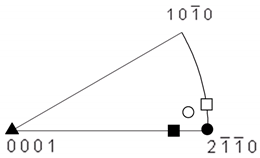Microstructural Characterization of Friction-Stir Processed Ti-6Al-4V
Abstract
1. Introduction
2. Materials and Methods
3. Results and Discussion
3.1. Preliminary Analysis
3.2. Microstructure Distribution within Stir Zone
3.3. Microstructure Morphology and Grain Size
3.4. Texture
3.5. Misorientation Distribution
4. Conclusions
Supplementary Materials
Author Contributions
Funding
Conflicts of Interest
References
- Mishra, R.S.; Ma, Z.Y. Friction stir welding and processing. Mater. Sci. Eng. R 2005, 50, 1–78. [Google Scholar] [CrossRef]
- Juhas, M.C.; Viswanathan, G.B.; Fraser, H.L. Microstructural evolution in Ti alloy friction stir welds. In Proceedings of the Second Symposium on Friction Stir Welding, Gothenburg, Sweden, 26–28 June 2000. [Google Scholar]
- Juhas, M.C.; Viswanathan, G.B.; Fraser, H.L. Characterization of microstructural evolution in a Ti-6Al-4V friction stir weld. In Proceedings of the Lightweight Alloys for Aerospace Application, TMS, Warrendale, PA, USA, 12–14 February 2001; Jata, K., Lee, E.W., Frazier, W., Kim, N.J., Eds.; TMS: Warrendale, PA, USA, 2001; pp. 209–217. [Google Scholar]
- Ramirez, A.J.; Juhas, M.C. Microstructural evolution in Ti-6Al-4V friction stir welds. In Material Science Forum; Trans Tech Publications Ltd.: Zurich-Uetikon, Switzerland, 2003; Volume 426, pp. 2999–3004. [Google Scholar]
- Pavka, P.A. Microstructural Evolution of Friction Stir Processed Ti-6Al-4V. Ph.D. Thesis, Ohio State University, Columbus, OH, USA, 2006. [Google Scholar]
- Pilchak, A.L.; Juhas, M.C.; Williams, J.C. Microstructural changes due to friction stir processing of investment-cast Ti-6Al-4V. Metall. Mater. Trans. A 2007, 38, 401–408. [Google Scholar] [CrossRef]
- Pilchak, A.L.; Li, Z.T.; Fisher, J.J.; Reynolds, A.P.; Juhas, M.C.; Williams, J.C. The relationship between friction stir processing (FSP) parameters and microstructure in investment cast Ti-6Al-4V. In Friction Stir Welding and Processing IV; Mishra, R.S., Mahoney, M.W., Lienert, T.J., Jata, K.V., Eds.; TMS: Warrendale, PA, USA, 2007; pp. 419–427. [Google Scholar]
- Pilchak, A.L.; Juhas, M.C.; Williams, J.C. The effect of friction stir processing on microstructure and properties of investment cast Ti-6Al-4V. In Proceedings of the 11th World Titanium 2007 Conference, Kyoto, Japan, 3–7 June 2007; Ninomi, M., Akiyama, S., Ikeda, M., Hagiwara, M., Maruyama, K., Eds.; Japan Institute of Metals: Sendai, Japan, 2007; pp. 1723–1726. [Google Scholar]
- Pilchak, A.L.; Juhas, M.C.; Williams, J.C. Observations of tool-workpiece interactions during friction stir processing of Ti-6Al-4V. Metall. Mater. Trans. A 2007, 38, 435–437. [Google Scholar] [CrossRef]
- Pilchak, A.L.; Norfleet, D.M.; Juhas, M.C.; Williams, J.C. Friction stir processing of investment-cast Ti-6Al-4V: Microstructure and properties. Metall. Mater. Trans. A 2008, 39, 1519–1524. [Google Scholar] [CrossRef]
- Pilchak, A.L.; Juhas, M.C.; Williams, J.C. A comparison of friction stir processing of investment cast and mill-annealed Ti-6Al-4V. Weld. World 2008, 52, 60–68. [Google Scholar] [CrossRef]
- Lauro, A. Friction stir welding of titanium alloys. Weld. Int. 2012, 26, 8–21. [Google Scholar] [CrossRef]
- Su, J.; Wang, J.; Mishra, R.S.; Xu, R.; Baumann, J.A. Microstructure and mechanical properties of a friction stir processed Ti-6Al-4V alloy. Mater. Sci. Eng. A 2013, 573, 67–74. [Google Scholar] [CrossRef]
- Lippold, J.C.; Livingston, J.J. Microstructure evolution during friction stir processing and hot torsion simulation of Ti-6Al-4V. Metall. Mater. Trans. A 2013, 44, 3815–3825. [Google Scholar] [CrossRef]
- Edwards, P.; Ramulu, M. Identification of process parameters for friction stir welding Ti-6Al-4V. J. Eng. Mater. Technol. 2010, 132, 031006–1. [Google Scholar] [CrossRef]
- Edwards, P.; Ramulu, M. Effect of process conditions on superplastic forming behavior in Ti-6Al-4V friction stir welds. Sci. Technol. Weld. Join. 2009, 14, 669–680. [Google Scholar] [CrossRef]
- Sanders, D.G.; Ramulu, M.; Edwards, P.D.; Cantrell, A. Effect on the surface texture, superplastic forming, and fatigue performance of Titanium 6Al-4V friction stir welds. J. Mater. Eng. Perform. 2010, 19, 503–509. [Google Scholar] [CrossRef]
- Edwards, P.D.; Ramulu, M. Investigation of microstructure, surface and subsurface characteristics in titanium alloy friction stir welds of varied thicknesses. Sci. Technol. Weld. Join. 2009, 14, 476–483. [Google Scholar] [CrossRef]
- Wang, J.; Su, J.; Mishra, R.S.; Xu, R.; Baumann, J.A. Tool wear mechanisms in friction stir welding of Ti-6Al-4V. Wear 2014, 321, 25–32. [Google Scholar] [CrossRef]
- Pilchak, A.L.; Tang, W.; Sahiner, H.; Reynolds, A.P.; Williams, J.C. Microstructure evolution during friction stir welding of mill-annealed Ti-6Al-4V. Metall. Mater. Trans. A 2011, 42, 745–762. [Google Scholar] [CrossRef]
- Fall, A.; Fesharaki, M.H.; Khodabandeh, A.R.; Jahazi, M. Tool wear characteristics and effect on microstructure in Ti-6Al-4V friction stir welded joints. Metals 2016, 6, 275. [Google Scholar] [CrossRef]
- Wu, L.H.; Wang, D.; Xiao, B.L.; Ma, Z.Y. Tool wear and its effect on microstructure and properties of friction stir processed Ti-6Al-4V. Mater. Chem. Phys. 2014, 146, 512–522. [Google Scholar] [CrossRef]
- Kitamura, K.; Fujii, H.; Iwata, Y.; Sun, Y.S.; Morisada, Y. Flexible control of the microstructure and mechanical properties of friction stir welded joints. Mater. Design 2013, 46, 348–354. [Google Scholar] [CrossRef]
- Yoon, S.; Ueji, R.; Fujii, H. Effect of rotation rate on microstructure and texture evolution during friction stir welding of Ti-6Al-4V plates. Mater. Character. 2015, 106, 352–358. [Google Scholar] [CrossRef]
- Zhou, L.; Liu, H.J.; Liu, P.; Liu, Q.W. The stir zone microstructure and its formation mechanism in Ti-6Al-4V friction stir welds. Scripta Mater. 2009, 61, 596–599. [Google Scholar] [CrossRef]
- Liu, H.J.; Zhou, L.; Liu, Q.W. Microstructural characteristics and mechanical properties of friction stir welded joints of Ti-6Al-4V titanium alloy. Mater. Design 2010, 31, 1650–1655. [Google Scholar] [CrossRef]
- Liu, H.J.; Zhou, L. Microstructural zones and tensile characteristics of friction stir welded joint of TC4 titanium alloy. Trans. Nonferrous. Met. Soc. China 2010, 20, 1873–1878. [Google Scholar] [CrossRef]
- Zhou, L.; Liu, H.-J.; Wu, L.-Z. Texture of friction stir welded Ti-6Al-4V alloy. Trans. Nonferrous Met. Soc. China 2014, 24, 368–372. [Google Scholar] [CrossRef]
- Farnoush, H.; Bastami, A.A.; Sadeghi, A.; Mohandesi, J.A.; Moztarzadeh, F. Tribological and corrosion behavior of friction stir processed Ti-CaP nanocomposites in simulated body fluid solution. J. Mech. Beh. Biomed. Mater. 2013, 20, 90–97. [Google Scholar] [CrossRef] [PubMed]
- Esmaily, M.; Mortazavi, S.N.; Todehfalah, P.; Rashidi, M. Microstructural characterization and formation of α/ martensite phase in Ti-6Al-4V alloy butt joints produced by friction stir and gas tungsten arc welding processes. Mater. Design 2013, 47, 143–150. [Google Scholar] [CrossRef]
- Pasta, S.; Reynolds, A.P. Residual stress effects on fatigue crack growth in a Ti-6Al-4V friction stir welds. Fatigue Fract. Eng. Mater. Struct. 2008, 31, 569–580. [Google Scholar] [CrossRef]
- Steuwer, A.; Hattingh, D.G.; James, M.N.; Singh, U.; Buslaps, T. Residual stress, microstructure and tensile properties in Ti-6Al-4V friction stir welds. Sci. Technol. Weld. Join. 2012, 17, 525–533. [Google Scholar] [CrossRef]
- Muzvidziwa, M.; Okazaki, M.; Suzuki, K.; Hirano, S. Role of microstructure on the fatigue crack propagation behavior of a friction stir welded Ti-6Al-4V. Mater. Sci. Eng. A 2016, 652, 59–68. [Google Scholar] [CrossRef]
- Yoon, S.; Ueji, R.; Fujii, H. Microstructure and texture distribution of Ti-6Al-4V alloy joints friction stir welded below β-transus temperature. J. Mater. Process. Technol. 2016, 229, 390–397. [Google Scholar] [CrossRef]
- Ma, Z.Y.; Pilchak, A.L.; Juhas, M.C.; Williams, J.C. Microstructural refinement and property enhancement of cast light alloys via friction stir processing. Scripta Mater. 2008, 58, 361–366. [Google Scholar] [CrossRef]
- Zhang, W.; Liu, H.; Ding, H.; Fujii, H. Superplastic deformation mechanism of the friction stir processed fully lamellar Ti-6Al-4V alloy. Mater. Sci. Eng. A. 2020, 785, 139390. [Google Scholar] [CrossRef]
- Ramulu, M.; Edwards, P.D.; Sanders, D.G.; Reynolds, A.P.; Trapp, T. Tensile properties of friction stir welded and friction stir welded-superplastically formed Ti-6Al-4V butt joints. Mater. Design 2010, 31, 3056–3061. [Google Scholar] [CrossRef]
- Sanders, D.G.; Ramulu, M.; Edwards, P.D. Superplastic forming of friction stir welds in Titanium alloy 6Al-4V: Preliminary results. Mater. Sci. Eng. Technol. 2008, 39, 353–357. [Google Scholar] [CrossRef]
- Edwards, P.D.; Sanders, D.G.; Ramulu, M. Simulation of tensile behavior in friction stir welded and superplastically formed Titanium 6Al-4V alloy. J. Mater. Eng. Perform. 2010, 19, 510–514. [Google Scholar] [CrossRef]
- Sanders, D.G.; Ramulu, M.; Klock-McCook, E.J.; Edwards, P.D.; Reynolds, A.P.; Trapp, T. Characterization of superplastically formed friction stir weld in titanium 6Al-4V: Preliminary results. J. Mater. Eng. Perform. 2008, 17, 187–192. [Google Scholar] [CrossRef]
- Edwards, P.D.; Sanders, D.G.; Ramulu, M.; Grant, G.; Trapp, T.; Comley, P. Thinning behavior simulations in superplastic forming of friction stir processed titanium 6Al-4V. J. Mater. Eng. Perform. 2010, 19, 481–487. [Google Scholar] [CrossRef]
- Pilchak, A.L.; Williams, J.C. Microstructure and texture evolution during friction stir processing of fully lamellar Ti-6Al-4V. Metall. Mater. Trans. A 2011, 42, 773–794. [Google Scholar] [CrossRef]
- Humphreys, F.J. Quantitative metallography by electron backscattered diffraction. J. Microsc. 1999, 195, 170–185. [Google Scholar] [CrossRef]
- Ji, S.; Li, Z.; Wang, Y.; Ma, L. Joint formation and mechanical properties of back heating assisted friction stir welded Ti-6Al-4V alloy. Mater. Design 2017, 113, 37–46. [Google Scholar] [CrossRef]
- Buffa, G.; Fratini, L.; Schneider, M.; Merklein, M. Micro and macro mechanical characterization of friction stir welded Ti-6Al-4V lap joints through experiments and numerical simulation. J. Mater. Process. Technol. 2013, 213, 2312–2322. [Google Scholar] [CrossRef]
- Yoon, S.; Ueji, R.; Fujii, H. Effect of initial microstructure on Ti-6Al-4V joint by friction stir welding. Mater. Design 2015, 88, 1269–1276. [Google Scholar] [CrossRef]
- Fonda, R.W.; Bingert, J.F.; Colligan, K.J. Development of grain structure during friction stir welding. Scripta Mater. 2004, 51, 243–248. [Google Scholar] [CrossRef]
- Fonda, R.W.; Knipling, K.E. Texture development in friction stir welds. Sci. Technol. Weld. Join. 2011, 16, 288–294. [Google Scholar] [CrossRef]
- Park, S.H.C.; Sato, Y.S.; Kokawa, H. Basal plane texture and flow pattern in friction stir weld of a magnesium alloy. Metall. Mater. Trans. A 2003, 34, 987–994. [Google Scholar] [CrossRef]
- Reynolds, A.P.; Hood, E.; Tang, W. Texture in friction stir welds of Timetal 21S. Scripta Mater. 2005, 52, 491–494. [Google Scholar] [CrossRef]
- Li, S. Orientation stability in equal channel angular extrusion. Part. II: Hexagonal close-packed material. Acta Mater. 2008, 56, 1031–1043. [Google Scholar] [CrossRef]
- Beausir, B.; Toth, L.S.; Neale, K.W. Ideal orientations and persistence characteristics of hexagonal close packed crystals in simple shear. Acta Mater. 2007, 55, 2696–2705. [Google Scholar] [CrossRef]
- Mironov, S.Y.; Salischev, G.A.; Myshlayaev, M.M.; Pippan, R. Evolution of misorientation distribution during warm ‘abc’ forging of commercial-purity titanium. Mater. Sci. Eng. A 2006, 418, 257–267. [Google Scholar] [CrossRef]
- Dyakonov, G.S.; Mironov, S.; Semenova, I.P.; Valiev, R.Z.; Semiatin, S.L. Microstructure evolution and strengthening mechanisms in commercial purity titanium subjected to equal-channel angular pressing. Mater. Sci. Eng. A 2017, 701, 289–301. [Google Scholar] [CrossRef]
- Mironov, S.; Sato, Y.S.; Kokawa, H. Development of grain structure during friction stir welding of pure titanium. Acta Mater. 2009, 57, 4519–4528. [Google Scholar] [CrossRef]
- Gey, N.; Hubert, M. Characterization of the variant selection occurring during the α→β→α phase transformations of a cold rolled titanium sheet. Acta Mater. 2002, 50, 277–287. [Google Scholar] [CrossRef]
- Wang, S.C.; Aindow, M.; Starink, M.J. Effect of self-accommodation on α/α boundary populations in pure titanium. Acta Mater. 2003, 51, 2485–2503. [Google Scholar] [CrossRef]
- Dyakonov, G.S.; Mironov, S.; Semenova, I.P.; Valiev, R.Z.; Semiatin, S.L. EBSD analysis of grain-refinement mechanisms operating during equal-channel angular pressing of coppercial-purity titanium. Acta Mater. 2019, 173, 174–183. [Google Scholar] [CrossRef]
- Prakash, D.G.L.; Ding, R.; Morat, R.J.; Jones, I.; Withers, P.J.; Quinta da Fonseca, J.; Preuss, M. Deformation twinning in Ti-6Al-4V during low strain rate deformation to moderate strains at room temperature. Mater. Sci. Eng. A 2010, 527, 5734–5744. [Google Scholar] [CrossRef]
- Semiatin, S.L.; Levkulich, N.C.; Salem, A.A.; Pilchak, A.L. Plastic flow during hot working of Ti-7Al. Metall. Mater. Trans A 2020, 1–16, in press. [Google Scholar] [CrossRef]

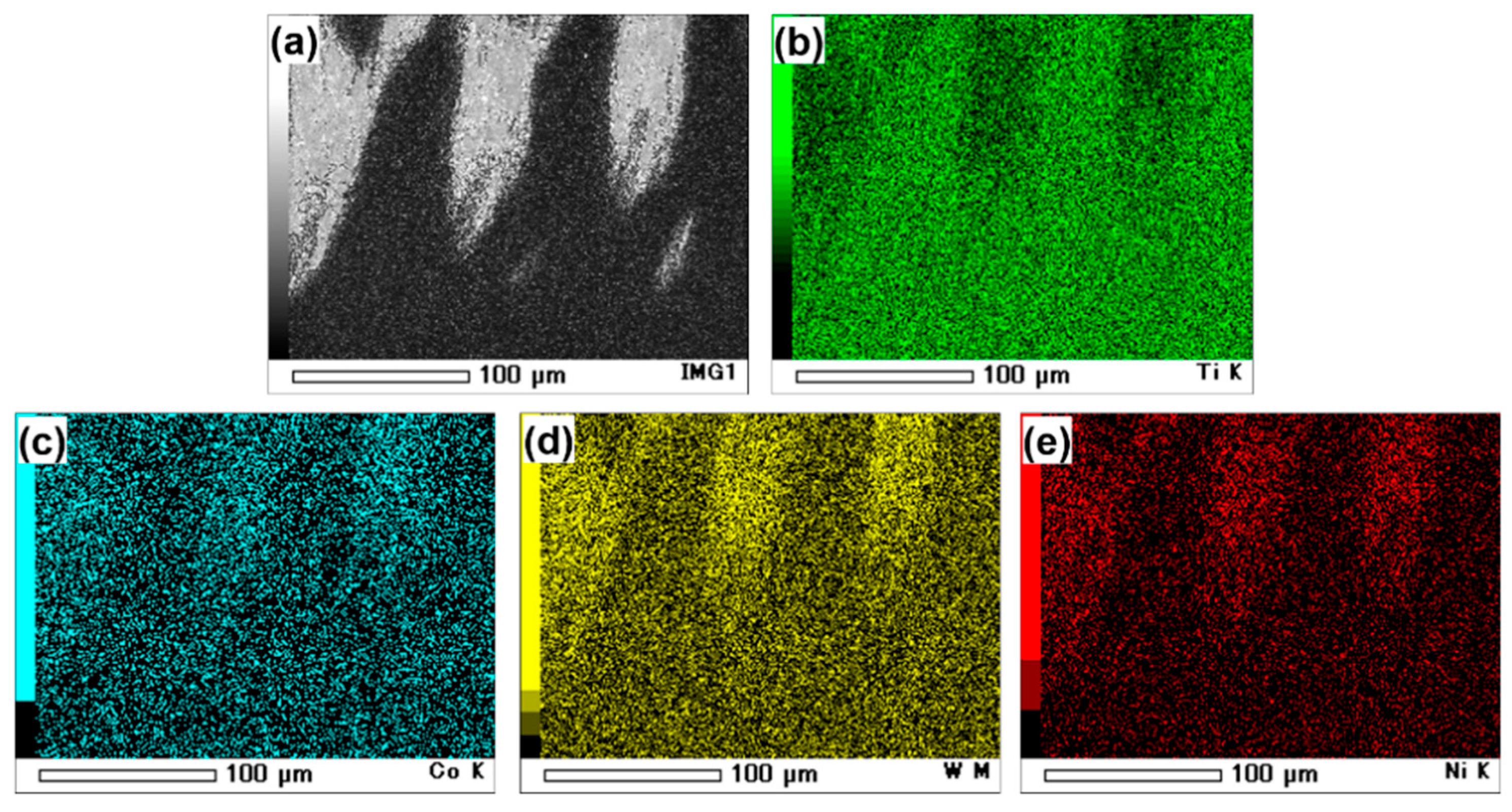

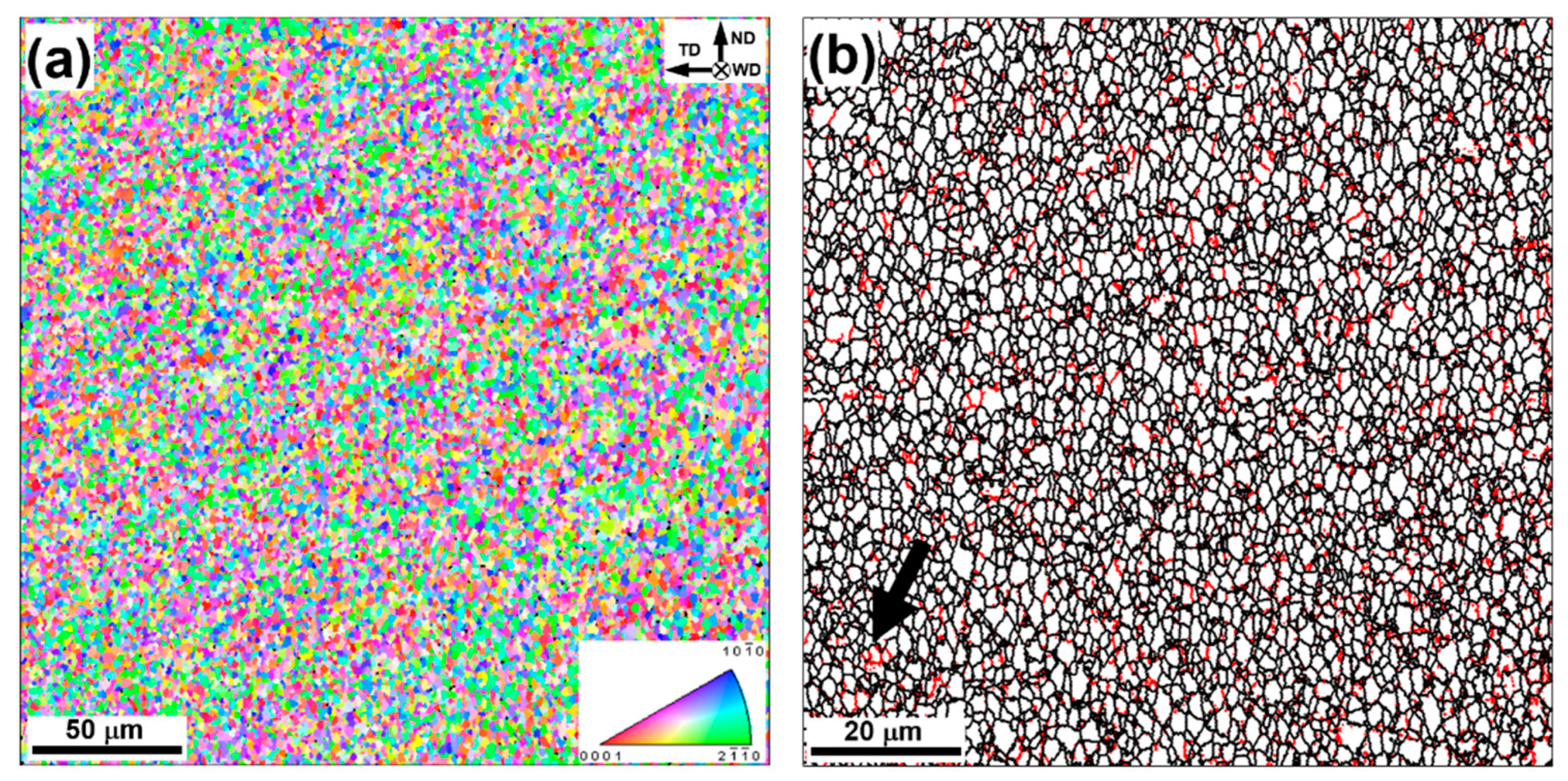
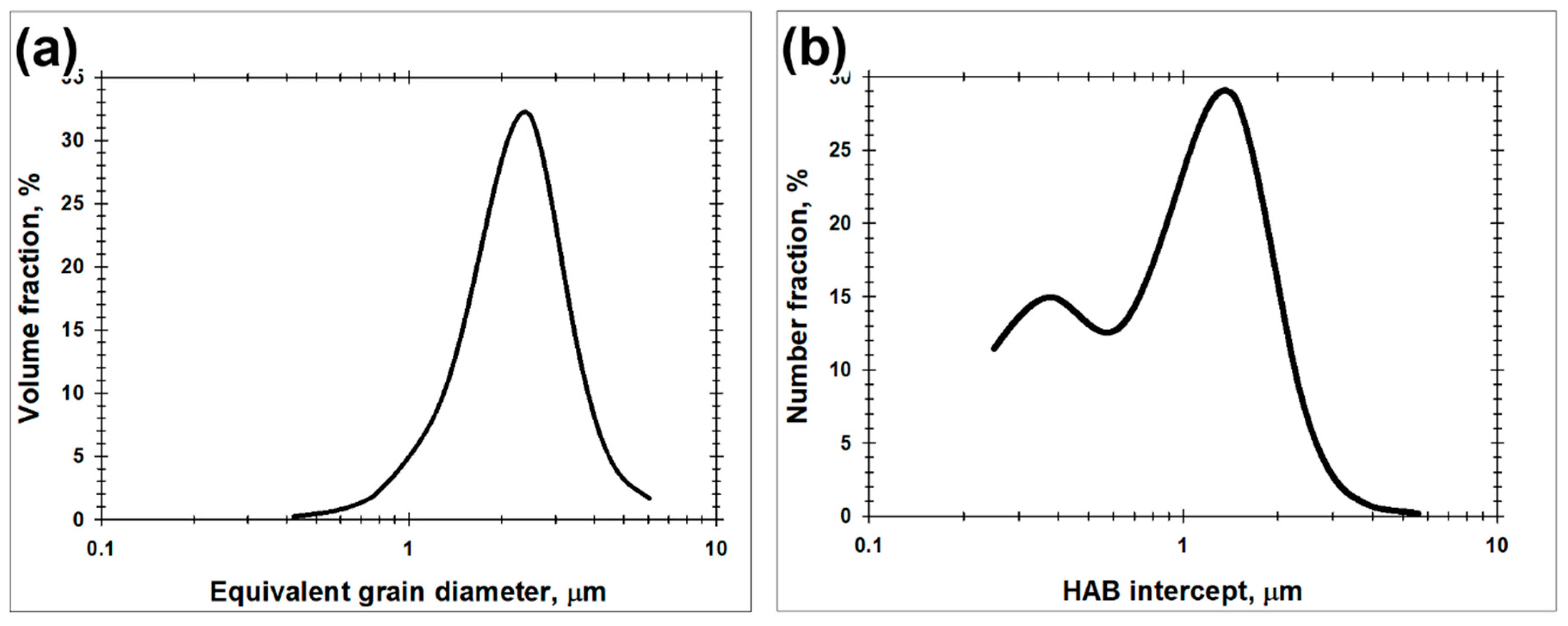
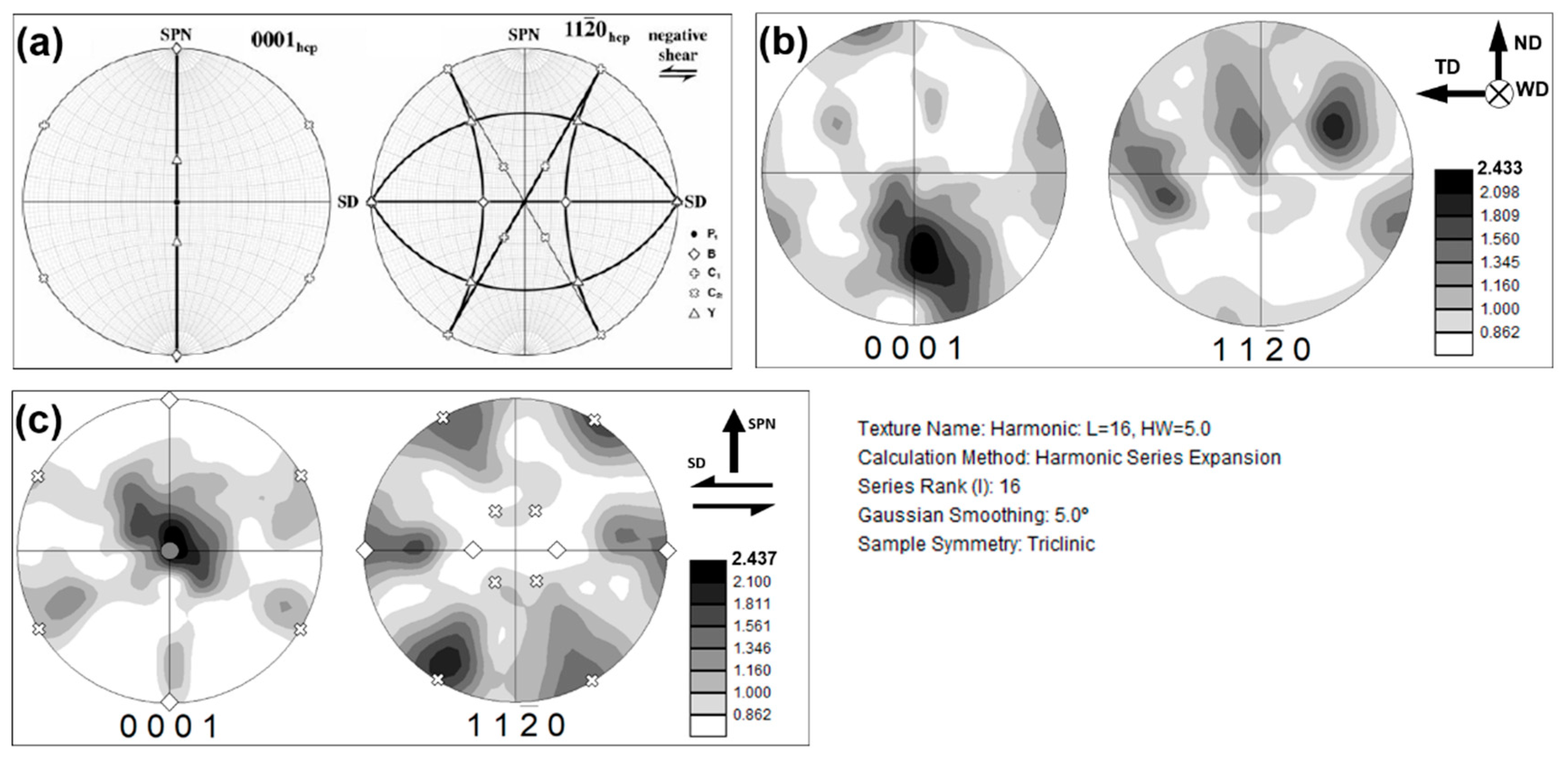
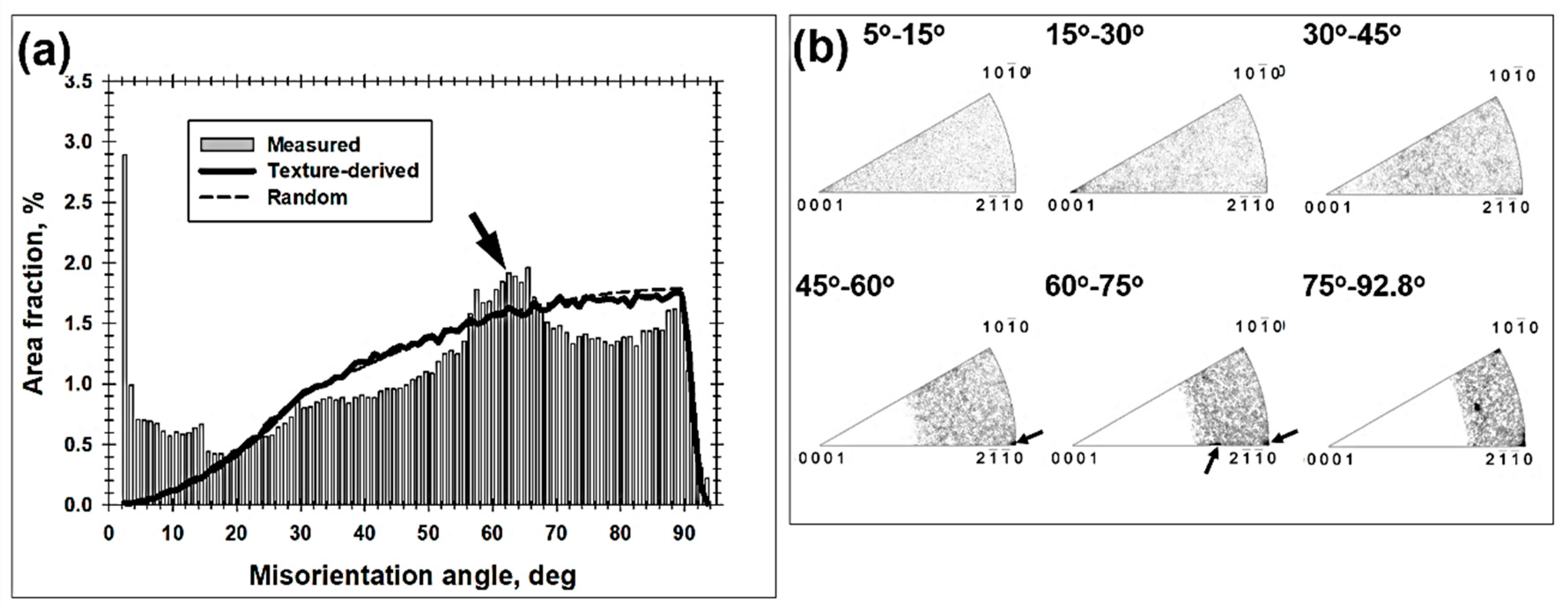
| Notation | Euler Angles (φ1, Φ, φ2) | Miller-Bravais Indices {hkil}<uvtw> | Primary Slip Mode |
|---|---|---|---|
| P-fiber | (0;0–90;0) | Prism <a> slip | |
| P1 | (0;0;0) | Prism <a> slip | |
| B-fiber | (0;90;0–60) | Basal <a> slip | |
| Y-fiber | (0;30;30–60) | - | Pyramidal <a> slip |
| C-fiber | (60;90;0–60) | - | Pyramidal <c+a> slip |
© 2020 by the authors. Licensee MDPI, Basel, Switzerland. This article is an open access article distributed under the terms and conditions of the Creative Commons Attribution (CC BY) license (http://creativecommons.org/licenses/by/4.0/).
Share and Cite
Mironov, S.; Sato, Y.S.; Kokawa, H.; Hirano, S.; Pilchak, A.L.; Semiatin, S.L. Microstructural Characterization of Friction-Stir Processed Ti-6Al-4V. Metals 2020, 10, 976. https://doi.org/10.3390/met10070976
Mironov S, Sato YS, Kokawa H, Hirano S, Pilchak AL, Semiatin SL. Microstructural Characterization of Friction-Stir Processed Ti-6Al-4V. Metals. 2020; 10(7):976. https://doi.org/10.3390/met10070976
Chicago/Turabian StyleMironov, Sergey, Yutaka S. Sato, Hiroyuki Kokawa, Satoshi Hirano, Adam L. Pilchak, and Sheldon Lee Semiatin. 2020. "Microstructural Characterization of Friction-Stir Processed Ti-6Al-4V" Metals 10, no. 7: 976. https://doi.org/10.3390/met10070976
APA StyleMironov, S., Sato, Y. S., Kokawa, H., Hirano, S., Pilchak, A. L., & Semiatin, S. L. (2020). Microstructural Characterization of Friction-Stir Processed Ti-6Al-4V. Metals, 10(7), 976. https://doi.org/10.3390/met10070976






